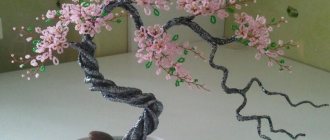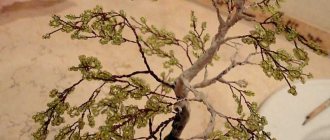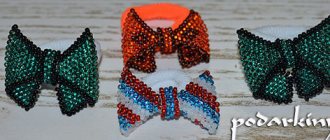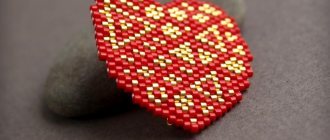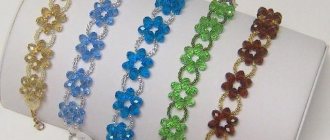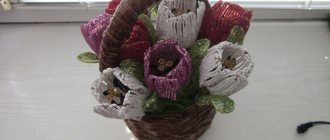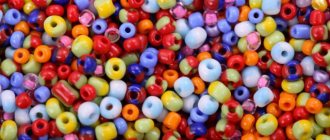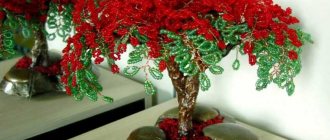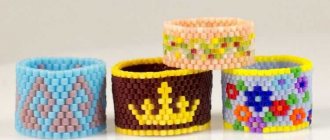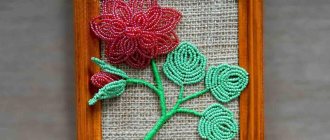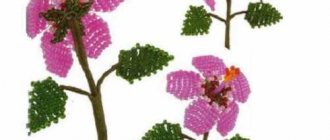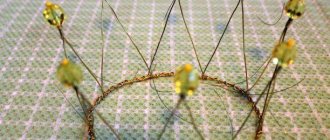Basic beading techniques
Since its inception, the technique of this type of needlework has constantly improved and become more complex. Five types of weaving techniques are widely used:
- Weaving a fishing line or wire with one thread.
- Simultaneous weaving with two threads (working with both ends of one thread).
- Parallel weaving is a more complicated option that allows you to create more complex figures. This option involves stringing beads from both ends, and the thread is threaded through the beads several times.
- Mosaic weaving is a technique of dense bead weaving.
- "Brick stitch" An ancient technique in which the canvas has the appearance of brickwork.
What to consider first
Those wishing to express themselves in this art form are not decreasing. And, of course, for all newcomers, the pressing question is where to start. The answer is banal, from mastering simple things.
Here we will look at beading techniques for creating simple things, specifically how to make animals from beads. Beading animals will help you master weaving techniques such as parallel, mosaic and brick stitch.
All beaded animal figures are divided into two large groups: flat and three-dimensional. It is advisable to start mastering the art of beading from flat figures and, as your skills increase, gradually move on to knitting three-dimensional figures.
To simplify the work, it is advisable to select animals that have few additional parts. This, among other things, will allow you to focus on weaving techniques.
For beginners, it is advisable to knit on a thin flexible wire so that the product can be given the desired shape.
Volumetric forms require mastery of parallel weaving techniques and other techniques. To create a three-dimensional figure, you must be guided by the appropriate diagrams.
Explaining the process of creating animals from beads for beginners with diagrams greatly facilitates and speeds up the work. The diagram determines the beginning of the weaving of the figure; it indicates the point of attachment of additional parts: paws, legs, etc.
Second class. Volumetric crafts
How to weave a crocodile
Making three-dimensional toys with your own hands is both difficult and interesting at the same time. Having mastered flat weaving, you can move on to a more complex level. Animals, of course, are more interesting to weave in volume. To make this four-dimensional crocodile you need to master the technique of parallel weaving.
INTERESTING: Volumetric deer made of beads
- We string two green beads of the first row and two yellow beads of the second onto a metal thread.
- We pass one end of the wire towards the other through the yellow beads and tighten it.
- Next, you can weave according to the pattern, pulling the green rows together and the yellow rows separately. To do this, you can periodically make fastening ties during weaving.
- Don't forget to insert the eyes in the right place. It's more interesting if they are red.
- If you tie a loop to the nose of the toy, the crocodile can be used as a keychain.
From the same pattern they weave a voluminous lizard and even the Snake Gorynych.
Making a dog out of beads
For a flat dog with beads you will need four colors of beads, of which six beads are small black beads, one large black, another pink bead and the main color for the dog will be brown, and in addition it will be yellowish, milky, you can even take white.
We will also need a pattern according to which we will weave. For convenience, place the diagram in front of you so that it is visible, since the presentation of the material will be related to the diagram. The weaving of the dog is done on thin copper wire; you will need about a meter of it.
Step one. Weaving a dog's body
The weaving process is carried out from the bottom up. We start from the tail of the craft. We collect three brown beads and five milk beads. After this we make a wire wrap. To do this, separate one fifth bead from the rest and pass the wire through all the remaining beads.
This end of the wire should be left short; you won’t have to work with it anymore. Next we will weave along a long wire. Now we move on to the row indicated by the arrow in the diagram, the first row from the bottom. On this row we will also make the dog’s legs.
In this row we collect four brown beads onto the long tip and lower them to the tail. After this we begin to make the legs. We collect three milky beads according to our scheme.
Attention, now we have a crucial moment. We lower them down again and make a circle with wire. To do this, move away the three outer beads and insert the end of the wire into the remaining three, you should get a ring. Next, tighten the wire.
After tightening, we should have a small dog's leg. Further according to the scheme there is one black bead and then again four brown ones. We repeat the operation exactly as we did on the first leg. We get a row with two legs.
After that, go to the second row and simply string all eleven beads onto the wire, and then connect the long wire with the short tip. We cut off the short end and hide it.
And then the long end must be passed through eleven beads of the first row. Now we collect the third row, and pass the tip through all the beads of the previous row and so on until the end of the row where the mouth is located. The result is the body of a dog.
Step two. Braiding a dog's head
We begin to weave the dog's head. First, we will weave a row where we have four and three beads according to the pattern. Let's start with a row with four beads, and then with three beads, that is, vice versa.
So, we collect our wire from a row with four beads, only three milky beads, after that we collect a row where there were three beads with a tongue: one milky bead, then a pink one and again a milky one.
The following is the same weaving principle as for the dog’s paws. Separate three beads, and pass the wire through the second (middle) bead, creating a loop. We tighten the wire and get a convex tongue. And only now we collect one more bead, the fourth, in a row with four beads.
And after that you need to pass the wire into the previous row. This connects the head with the body. The same principle applies to the nose. You should get a convex nose and mouth. After this, we continue to weave the eyes and ears in the same way as we wove the body.
Beautiful butterfly
Beading is a fun and rewarding activity, especially for children. In the course of work, fine motor skills develop, concentration increases, perseverance develops, and a desire arises to complete the task. Get your child involved and try to weave a cute butterfly.
Related article: Do-it-yourself stained glass on paper step by step: how to draw with a template
Our master class will help with this.
Prepare large light brown beads, smaller beads, and wire. Start with the body of the butterfly. Place one bead in the center of the wire, then cross the ends of the thread through the second bead and tighten.
Continue stringing beads as shown in the picture. Form the antennae. To do this, put one small bead on each wire and twist it.
Wings. Start with a circle. Take a new piece of wire and put 9 blue beads on it. Wrap them in a circle. Next, collect 16 pink beads and round them off. And repeat the second circle of 30 pieces, like the previous one.
Make two rows of beads from the new wire. There will be 22 pieces in the first row, 18 pieces in the second.
Next, put on 19 pieces on the left side, and 4 pieces on the right side. Thread the right side of the wire through the 18 beads. It will turn out like this.
Repeat steps 5 more times.
Attach the finished wing to the body of the moth and weave the second one by analogy. Connect all the parts together. Thus, a wonderful butterfly was made from beads and wire.
Educational models of weaving animals from beads
Using the example of a dog, we examined in detail parallel beading and how to use patterns, so you can start making figures yourself. For further development of skills, we provide model examples of weaving various animal figures from beads without weaving patterns in the form of keychains. They are so simple that they don't even require diagrams.
They are made according to the type of mosaic and parallel weaving. Before finishing work, attach a metal ring to the keychain and the gift is ready for friends.
And here are more complex educational models of animal weaving.
Create a dolphin from beads
A very simple dolphin craft for beginners to practice the parallel method and at the same time it is a good souvenir.
Making a spider from beads
This model already uses a more complex material: round and tubular beads with several shades. Weaving is performed using a parallel technique.
Create a lizard from beads
Weaving is done in a parallel way using beads of various colors.
Making a mouse from beads
There are two mouse options for work: one is monochromatic, and the other is larger and two-color. Both options are made according to the type of weaving.
https://youtu.be/1H0mF3mUFhMhttps://youtu.be/5CwwI-61DW4
_
